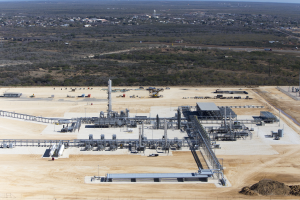Fracking Boom Pours Toxic Cloud Over South Texans

Photo by Al Braden
The Eagle Ford Shale play in south Texas is the 400-mile-long area that has become home to one of the country’s biggest energy booms in the past six years. The thousands of oil and gas wells producing in the region have brought dangerous air pollution to residents.
The Center for Public Integrity, InsideClimate News and The Weather Channel released a new exposé titled, “Fracking the Eagle Ford Shale: Big Oil & Bad Air on the Texas Prairie,” last week. Their eight month investigation reveals the dangers that come with fracking in the form of toxic chemicals released into the air as a result of the complicit culture of the government of Texas. In case you just want to read the highlights of the report, the team was nice enough to summarize their major findings:
- Texas’ air monitoring system is so flawed that the state knows almost nothing about the extent of the pollution in the Eagle Ford. Only five permanent air monitors are installed in the 20,000-square-mile region, and all are at the fringes of the shale play, far from the heavy drilling areas where emissions are highest.
-

Anadarko Brasada Cyro Gas Plant, Phase 1 of 3, Cotulla, TX.
Photo by Al BradenThousands of oil and gas facilities, including six of the nine production sites near the Buehrings’ house, are allowed to self-audit their emissions without reporting them to the state. The Texas Commission on Environmental Quality (TCEQ), which regulates most air emissions, doesn’t even know some of these facilities exist. An internal agency document acknowledges that the rule allowing this practice “[c]annot be proven to be protective.”
- Companies that break the law are rarely fined. Of the 284 oil and gas industry-related complaints filed with the TCEQ by Eagle Ford residents between Jan. 1, 2010, and Nov. 19, 2013, only two resulted in fines despite 164 documented violations. The largest was just $14,250. (Pending enforcement actions could lead to six more fines).
- The Texas legislature has cut the TCEQ’s budget by a third since the Eagle Ford boom began, from $555 million in 2008 to $372 million in 2014. At the same time, the amount allocated for air monitoring equipment dropped from $1.2 million to $579,000.
- The Eagle Ford boom is feeding an ominous trend: A 100 percent statewide increase in unplanned, toxic air releases associated with oil and gas production since 2009. Known as emission events, these releases are usually caused by human error or faulty equipment.
- Residents of the mostly rural Eagle Ford counties are at a disadvantage even in Texas, because they haven’t been given air quality protections, such as more permanent monitors, provided to the wealthier, more suburban Barnett Shale region near Dallas-Fort Worth.

Photo by Al Braden
People who live near oil and gas development – for instance in Texas’s Eagle Ford Shale, Pennsylvania’s Marcellus Shale and North Dakota’s Bakken Shale – often experience the same symptoms: headaches, nausea, nosebleeds, body rashes and respiratory problems. These shared symptoms from around the country point to the need for increased air monitoring.
While the fracking debate over much of the past decade has focused on how fracking chemicals and methane can contaminate drinking water, scientists say that air pollution is an often overlooked, but equally serious problem.
The report says:
“If you have pockets of communities with the same symptoms downwind of similar sources, then there is a body of evidence,” said Isobel Simpson, an atmospheric scientist at the University of California, Irvine, who studies air pollution around the world.
Oil and gas production releases many toxic chemicals into the air, including carcinogens like benzene and the deadly gas hydrogen sulfide. While some residents that live near drilling activity in Texas have reported symptoms that are known to be effects of these chemicals, including breathing problems and severe headaches, a link could not be inferred between the drilling boom and sick residents because there was no scientific study to support the claims. Clearly, regulators should be researching these problems.
Karnes County, which sits at the epicenter of much of the heavy drilling in the Eagle Ford Shale, is particularly ripe with hydrogen sulfide. Hydrogen sulfide, a naturally occurring compound of crude oil and natural gas, can aggravate asthma and cause nausea, headaches and eye irritation in a few parts-per-million (ppm) or less. In lower concentrations hydrogen sulfide gives off a rotten-egg odor, at concentrations of 1,000 ppm or higher it can cause near instant death. According to data submitted to the Texas Railroad Commission by field operators, numerous fields in Karnes County have an average concentration that is above the lethal dose. In particular, the Person field has an average concentration of 16,399 ppm and a maximum concentration of 71,550 ppm.
While the Eagle Ford Shale has seen a 168-fold increase from 2008 to 2013, the Texas Commission on Environmental Quality (TCEQ), the state’s environmental agency that regulates air emissions, saw its operating budget slashed by 39% during that same period. The TCEQ has three commissioners that are appointed by governor of Texas, Rick Perry, who has publicly stated that he would like to dismantle the EPA. The state of Texas has sued the EPA more than a dozen times in the past decade. So the residents in South Texas feel somewhat disenfranchised because of the close relationship between government and big business.
[vimeo 86979931 w=500 h=281]
The full report – which includes videos, infographics and photos – is available on the Center for Public Integrity, InsideClimate News and The Weather Channel websites.